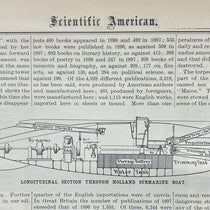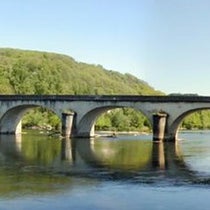Scientist of the Day - Robert Falcon Scott
Robert Falcon Scott, a British naval officer and polar explorer, was born June 6, 1868. Coming from a military family, Scott was always destined for the armed services, and he chose the Royal Navy for his career. He served on various ships in the 1880s and 1890s and distinguished himself as a capable young officer. But getting a command was difficult, as there were many talented aspiring officers competing for few slots. Scott happened to meet Clements Markham, at the time vice-president of the Royal Geographical Society, who had ambitions to sponsor an expedition to the South Pole. Markham and Scott seem to have gotten along well, and when Markham later became Society President and on the verge of announcing a polar expedition to Antarctica, Scott heard of the planned ventures and went to Markham's house to volunteer to lead such an expedition. The direct appeal worked; Scott was selected to command the British National Antarctic Expedition (1901-04), later usually called, after the name of their ship, the Discovery Expedition.
The Discovery expedition was the first British effort to explore the southern continent, after over 80 years of attempts at a Northwest Passage in the Arctic. Being cosponsored by the Royal Society of London, the Discovery expedition was intended to be a scientific enterprise, and plans did not include an attempt to reach the South Pole. Many future Antarctic explorers cut their teeth on the Discovery expedition, including not only Scott, but Ernest Shackleton, Edward Adrian Wilson, and Tom Crean. Scott and his men discovered the Emperor penguin rookery at Cape Crozier, and the Polar Plateau that lay between the coast and the South Pole. They had some problem getting home, when the Discovery refused to be budged from the ice and had to be dynamited free, but the venture was regarded in general as a successful initial expedition, enough so that when Markham proposed a second expedition, this one including an ascent to the South Pole, Scott was again chosen to lead it.
The Terra Nova expedition, again named after their ship (third image), began in 1910, and terminated for most of the team in 1913. Scott, however, and four of his men, perished from the cold, the last three, including Scott, on or around Mar. 29, 1912. Scott had found himself in a race for the Pole, since the Norwegian Roald Amundsen had mounted his own expedition at about the same time. Amundsen's party reached the Pole first, on Dec. 14, 1911, and returned safely by mid-January. Scott's party reached the pole on Jan. 17, 1912, and were of course bitterly disappointed to learn that the Norwegians had beaten them to the prize. Although Scott and his men had spent the previous year laying out food depots for the return journey, an unusually cold March, with temperatures below -40°, and a final blizzard that kept them in their tent, prevented them from reaching any caches of food. One man died on the way back, another left their tent and never returned, and the other three, including Scott, froze to death in their sleeping bags, to be found undisturbed the next fall. Scott, Wilson, and Henry Bowers were buried where they died, under a massive cairn of snow.
Scott kept a diary right up to the last day, and his calm prose, reflecting resolution and humanity in the face of disaster, is still stirring to read, and made him an instant hero to the British public. Statues of Scott were erected everywhere, and the Scott Polar Research Institute was established in his honor. Fifty years later, Scott’s reputation plummeted, in the aftermath of several biographies that compared Scott unfavorably to Amundsen and portrayed Scott as a bungler and a poor planner, refusing to use skis and dogs and fur clothing and relying on British gabardine and old-fashioned methods of man-hauling sledges. The last 25 years have been kinder to Scott, who is no longer cast as inept, and blame for the tragic ending is now usually assigned to the unusual, brutally severe weather encountered on the way back.
Last February, Edward Larson, author of a book on Scott, An Empire of Ice: Scott, Shackleton, and the Heroic Age of Antarctic Science (2011), spoke at our library, and Larson made the point, comparing Scott and Amundsen, that Scott's expedition was much more interested in scientific matters than Amundsen, who in fact had no scientific aspirations whatsoever – he simply wanted to get to the Pole and back as swiftly as possible. Before setting off for the Pole, Scott sent teams of men to gather geological specimens at the foot of the Antarctic glacier, and another team to the Cape Crozier rookery to gather live Emperor Penguin eggs for further study, and he even collected fossils on the trip to the Pole, when perhaps he should have been lightening the load on the sledges. If anything got Scott into trouble, it was his devotion to advancing the state of Antarctic science.
We have written posts on Apsley Cherry-Garrard and Edward Adrian Wilson, both of whom were part of the Terra Nova expedition, and both of whom went on the Winter Expedition of 1911 to find the Emperor penguin rookery. Wilson was selected to go for the pole and died in the tent with Scott; Cherry-Garrard came home to write a book about the Winter Expedition, which he titled: The Worst Journey in the World (1922). We have also done a post on Herbert Ponting, who was the official photographer for the Terra Nova expedition. He did not go to the Pole, so the photograph of Scott and his men at the Pole (first image) was a selfie, but Ponting took most of the other familiar expedition photographs, such as Scott’s last birthday party (fourth image), and Scott writing in his diary at base camp (fifth image), as well as the Winter Expedition team setting out for the penguin rookery in 1911, which you can see at the post on Cherry-Garrard.
Scott’s wife Kathryn was a sculptor, and several public statues of Scott were cast from her models. We show you one in New Zealand (sixth image).
William B. Ashworth, Jr., Consultant for the History of Science, Linda Hall Library and Associate Professor emeritus, Department of History, University of Missouri-Kansas City. Comments or corrections are welcome; please direct to ashworthw@umkc.edu.












